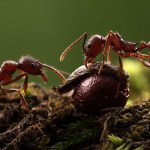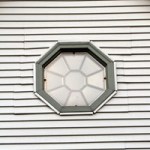Tricks of the Trade
Aphaenogaster woodland ants disperse a bloodroot seed. This image materialized in my head a couple months before I actually set it up.
My photographs fall into two categories: incidental shots I happen upon by chance, and premeditated images mapped out in advance. There's not much to say about the first type. I wander about in the woods as another camera-toting tourist, and sometimes I get lucky with an interesting subject. A naturalist's eye and a basic ability to operate photographic equipment suffice to produce usable photos.
As my photographic career progresses, though, more of my…
You've seen the ISO button on your camera. What does it do, and why does it matter?
ISO- an abbreviation for International Organization for Standardization- refers to a standard measure of the sensitivity of film or digital sensors to incoming light. The higher the ISO rating, the more sensitive the sensor and the less light required to form an image. Wikipedia carries a nice summary of the technical details.
Most digital cameras support a range of ISO ratings from 100 to 3200 or even higher. These ratings are calibrated so that a doubling in number indicates a doubling of sensitivity. ISO…
Polistes dominula, the European Paper Wasp
captured with an iPhone
As an insect guy, the first question I ask about any camera is: Can I shoot bugs with it?
To my great disappointment, the answer for most cell phones is no. Cell phone cameras are normally fixed to focus at distances useful for party pictures and street shots. Fixed-focus simplifies the mechanics of the onboard camera, but it also makes close-ups of small subjects impossible. Even Apple's iPhone 3GS- which has variable focus- doesn't focus quite closely enough do anything but the largest insects. So when an aphid plague…
As winter doesn't have much insect activity, it's the season I use to work on my equipment. Yesterday I tried out a new arrangement to diffuse the heads on my mt-24ex twin flash when the heads are mounted on long, moveable arms. Here's a time-lapse video showing the construction, plus a short clip of the gear in use:
Note the effect of the diffusion:
A bare, undiffused flash produces harsh shadows and glare
A diffused flash provides softer, more even lighting
Plectroctena mandibularis, South Africa
Every now and again someone asks how I get the white background on these sorts of stylized ant shots. Pretty simple: it's a sheet of cheap white printer paper. Overexposing the shot slightly by boosting the flash evens out the white.
I set the ant down on the paper under a petri dish or a lens cap, let her settle in, and remove the cover to get a few seconds of a relaxed ant before she's off to the races.
Photo details: Canon mp-e 65mm 1-5x macro lens on a Canon EOS 20D.
ISO 100, f13, 1/250th sec, diffuse twin flash
A reader asks:
I also have a MP-E lens with the MT-24EX flash unit. I was curious to know something I didnât see you mention in your recent blog post about this setup.
Could you share any technical points regarding how you achieve the visible backgrounds with that lens? In general, I get very nice shots with everything beyond the focused subject completely blacked out.
Since dark areas in photographs are the bits that aren't sending light to the camera, it follows that getting a visible backdrop means applying light behind the subject.
Earlier, I wrote that the black backdrop in insect…
A couple years back I posted a short bit on how to register photo copyright with the U.S. government. That turned out to be the last time I filled out a registration with pen and paper. For all subsequent submissions I've used the new ECO system at http://www.copyright.gov/eco.
Let me disabuse you of any preconception that the online method is easier. You'll need to clear an hour or two out of your schedule to prepare a submission. The new process involves clicking though an interminable array of confusing steps, filling out an order of magnitude more information than was requested in the…
Pogonomyrmex micans, stack of 23 images using CombineZP. Click for large file.
I don't ordinarily do product endorsements on the blog, but here's one: the image-stacking software CombineZP. I recommend it for two reasons. First, CombineZP produces smoother, more artifact-free images than the very expensive competition. Second, CombineZP is freeware. Alan Hadley, a British arthropod enthusiast, wrote it in his spare time.
Good. And free. Not much to argue with there.
CombineZP and similar products are designed to counter a major challenge of…
I've had several people ask me recently where to focus when taking insect photos. Here's my advice.
Aim for the eyes.
Compare:
A phorid fly sits atop a fungus, its compound eye slightly ahead of the focal plane.
The same fly with its eye in the focal plane.
The second photo should be more appealing than the first. Indeed, the first looks out of focus. Strictly speaking, though, this isn't true.
The top photo shows a much greater percentage of the body in focus than does the bottom photo. Look at how crisp the outline of the fly appears in comparison to the…
Malcom Gladwell to aspiring journalists:
The issue is not writing. It's what you write about. One of my favorite columnists is Jonathan Weil, who writes for Bloomberg. He broke the Enron story, and he broke it because he's one of the very few mainstream journalists in America who really knows how to read a balance sheet. That means Jonathan Weil will always have a job, and will always be read, and will always have something interesting to say. He's unique. Most accountants don't write articles, and most journalists don't know anything about accounting. Aspiring journalists should stop going…
For those of you accessible to central Illinois, I will be hosting a free insect photography workshop next Sunday at the University of Illinois Pollinatarium. The workshop is offered in celebration of the 3rd annual National Pollinator Week. Details are as follows:
Insect Photography Workshop
Free to the public
2:00 pm, June 28th, 2009
at the University of Illinois Pollinatarium (map)
Bring your camera, as this is a participatory event!
Among the least understood technical aspects of photography, at least for novices, is aperture. Yet aperture has profound effects on the resulting image. Consider the following series of photos, each taken with a macro setup of an MP-E lens on a Canon dSLR camera, focused at the foremost tip of an ant head head shot at increasingly smaller apertures:
What's going on?
Most lenses contain a diaphragm that can constrict from full open down to a little hole, controlling the amount of light that travels through the lens on its way to the film or sensor. The size of the hole…
I'll be giving an hour-long seminar on insect photography this coming Monday, February 2nd, as part of the University of Illinois Ecology and Evolutionary Biology "Ecolunch" series. Here are the details:
Alex Wild at Ecolunch
"Insect Photography: A How To For You Too"
***
February 2, 12-1pm
176 Burrill Hall
407 S Goodwin Ave
University of Illinois
Urbana, IL 61801
I'll be covering a few basic aspects of macro photography, including equipment, composition, and working with live insects.
Dalantech over at the No Cropping Zone writes:
From time to time I see people argue about the backgrounds in macro images, and about how dark backgrounds donât look natural âwhatever the heck that means. Seriously whatâs natural about macro photography? Do you see all the detail in a beeâs compound eye or the tiny âhairsâ that cover most leaves without the aid of some sort of magnifier?
I think Dalantech is entirely correct in that arguments about the naturalness of black backdrops are unconvincing. There are many reasons to take photographs, and capturing an animal in a particular…
Only one lens can take this shot
If you've paid attention to insect photography over the past decade, you'll likely have noticed that a single lens, Canon's MP-E 1-5x macro, has come to dominate the market. Every professional insect photographer I know owns one, and many of the dedicated amateurs do as well. Indeed, some photographers have even switched from Nikon to Canon just to be able to use it.
Yet the lens is also a throwback, possessing few of the electronic features of modern camera technology. It is largely manual, with no auto-focus or image stabilization,…
Apterobittacus apterus, California
I lived in California until a few years ago, and one thing I enjoyed about the Golden State was the unique insect fauna, full of bizarre and relictual creatures. One of the oddities was the wingless hangingfly, a leggy mecopteran that lurks in the coastal grasslands.
The insect above was photographed indoors. I made a makeshift studio out of various bits of debris lying around the lab: a matte black notebook for a backdrop, a jar to hold the grass upright, and the white lid to a styrofoam cooler propped a few inches above the insect. …
A deer flea hangs from a hair, California
I don't ordinarily hang around animal carcasses. But every now and again I'll brave a fresh roadkill to shoot the parasites as they jump ship from the cooling body. Fleas and lice are fascinating creatures, and as they are hardly ever photographed alive I can capture some unique images just by staking out a common subject that most people would not think to shoot.
photo details: Canon MP-E 65mm 1-5x macro lens on a Canon EOS D60
ISO 100, f/13, 1/200 sec, flash diffused through tracing paper
In an earlier discussion on the merits of megapixels, commentator and snail guru Aydin notes:
Megapixel counts matter if you need to crop out large sections of an image & still need to retain enough pixels for a large enough print.
To illustrate Aydin's point, I've taken a full photo of an Australian Monomorium nest and cropped it away to show just the queen ant:
Viola! Instant magnification. I can get away with a tight crop because the original photo spans over 6 million pixels. Blog photos only need 100,000 pixels. Plenty of pixels to spare. Once I get my hands on…
If you've ever spent time photographing ants the above shot will look familiar: off-frame and out of focus. Because ants are small and speedy, they are among the most difficult insects to photograph. Just capturing an active ant somewhere in the frame can be regarded as an achievement, never mind the more aesthetic concerns of lighting and composition. Yet ants are dominant insects nearly everywhere, and photographers who neglect them are missing out on one of our most important animals. Figuring out how to photograph these tricky insects is well worth the effort. If you can shoot ants,…
The smallest insect I've ever photographed made the cover of the scientific journal Genetics this week. Encarsia pergandiella, an aphelinid wasp not even a millimeter long, was the subject of a study by Perlmann, Kelly, and Hunter documenting the reproductive consequences of infection by bacterial parasite.
The wasp lab is downstairs from ours, so it wasn't much trouble to schlep my equipment over for an afternoon session. The goal was to create a set of images to submit to the journal as potential covers, and I was more than happy to have the opportunity to shoot these charismatic little…


